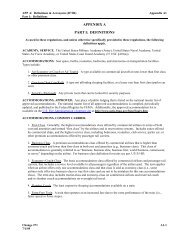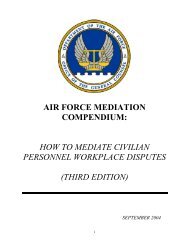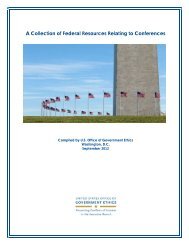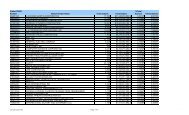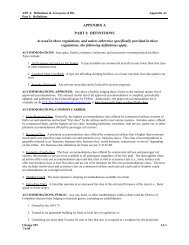SecArmy memorandum, Interim Guidance for Implementation of ...
SecArmy memorandum, Interim Guidance for Implementation of ...
SecArmy memorandum, Interim Guidance for Implementation of ...
Create successful ePaper yourself
Turn your PDF publications into a flip-book with our unique Google optimized e-Paper software.
ATTACHMENT 1<br />
RESPONSIBILITIES<br />
1. SECRETARY AND DEPUTY SECRETARY OF DEFENSE. The Secretary and Deputy<br />
Secretary <strong>of</strong> Defense are accountable <strong>for</strong> all <strong>of</strong> the Department's conference related activities.<br />
They will oversee DoD's conference policies and controls and maintain visibility and<br />
accountability <strong>for</strong> the conduct <strong>of</strong> conferences hosted by the Department and attended by<br />
Department employees through Component reporting on at least a quarterly basis and escalation<br />
procedures <strong>for</strong> unusual circumstances.<br />
2. APPROVAL AUTHORITIES. Approval authorities must ensure compliance with all<br />
applicable law and policy in making their authorizations and there<strong>for</strong>e may not approve a<br />
conference without coordination with appropriate legal counsel. Approval authorities must also<br />
maintain electronic records <strong>of</strong> documentation used in making their decisions. Additionally,<br />
approval authorities must sign a waiver/approval <strong>memorandum</strong> <strong>for</strong> each conference approved and<br />
maintain electronic copies <strong>of</strong> these memoranda. If, as the date <strong>of</strong> the conference approaches, it<br />
becomes apparent that its cost will exceed the estimated cost and breach the next higher approval<br />
threshold, approval must be obtained from the higher level approval authority as soon as possible.<br />
a. Conference alternatives. When making conference approval decisions, approval<br />
authorities must confirm that physical co location <strong>of</strong> DoD employees in a conference setting is<br />
necessary and cost-effective and consider alternative means <strong>of</strong> delivering the relevant<br />
in<strong>for</strong>mation, including usage <strong>of</strong> remote collaboration tools (e.g., teleconferencing,<br />
videoconferencing, webinars, online sharing applications) and other real-time communication<br />
methods that would mitigate the need <strong>for</strong> physical co location <strong>of</strong> DoD employees. While<br />
determinations should be made on a case-by-case basis, there are many circumstances where the<br />
proliferation <strong>of</strong> these tools and technologies may make physical colocation unnecessary, and such<br />
circumstances warrant increased scrutiny be<strong>for</strong>e moving <strong>for</strong>ward with a conference. Examples<br />
could include conferences designed to provide pr<strong>of</strong>essional development needed to keep skills<br />
current <strong>for</strong> human resources, accounting, procurement, or other government pr<strong>of</strong>essionals. By<br />
contrast, there may be limited circumstances where physical colocation remains necessary, such<br />
as bringing together law en<strong>for</strong>cement <strong>of</strong>ficials to conduct practical training on how to examine a<br />
crime scene, or conducting hands-on analysis <strong>of</strong> scientific research. However, approval<br />
authorities should begin their reviews by presuming that physical co location as part <strong>of</strong> a<br />
conference is not required in the majority <strong>of</strong> cases.<br />
4




